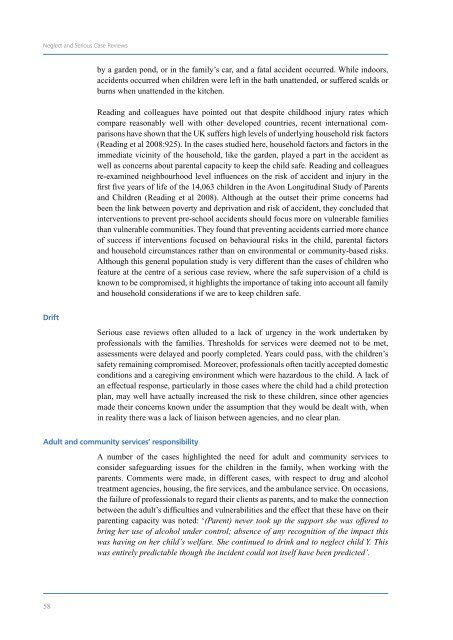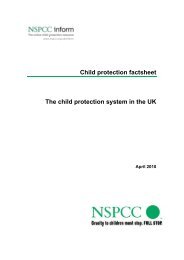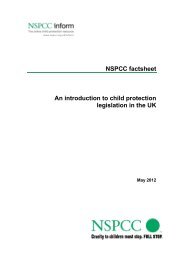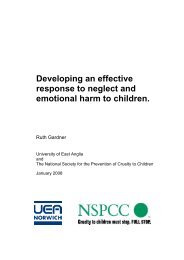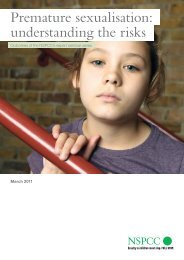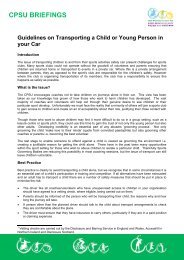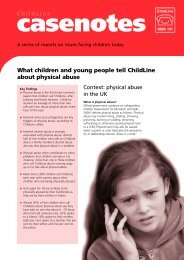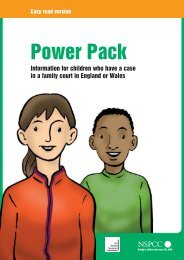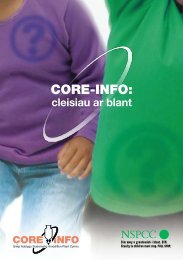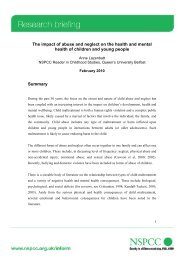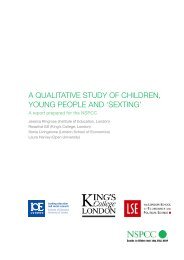Neglect and serious case reviews (PDF, 735KB) - nspcc
Neglect and serious case reviews (PDF, 735KB) - nspcc
Neglect and serious case reviews (PDF, 735KB) - nspcc
Create successful ePaper yourself
Turn your PDF publications into a flip-book with our unique Google optimized e-Paper software.
<strong>Neglect</strong> <strong>and</strong> Serious Case Reviews<br />
drift<br />
by a garden pond, or in the family’s car, <strong>and</strong> a fatal accident occurred. While indoors,<br />
accidents occurred when children were left in the bath unattended, or suffered scalds or<br />
burns when unattended in the kitchen.<br />
Reading <strong>and</strong> colleagues have pointed out that despite childhood injury rates which<br />
compare reasonably well with other developed countries, recent international comparisons<br />
have shown that the UK suffers high levels of underlying household risk factors<br />
(Reading et al 2008:925). In the <strong>case</strong>s studied here, household factors <strong>and</strong> factors in the<br />
immediate vicinity of the household, like the garden, played a part in the accident as<br />
well as concerns about parental capacity to keep the child safe. Reading <strong>and</strong> colleagues<br />
re-examined neighbourhood level influences on the risk of accident <strong>and</strong> injury in the<br />
first five years of life of the 14,063 children in the Avon Longitudinal Study of Parents<br />
<strong>and</strong> Children (Reading et al 2008). Although at the outset their prime concerns had<br />
been the link between poverty <strong>and</strong> deprivation <strong>and</strong> risk of accident, they concluded that<br />
interventions to prevent pre-school accidents should focus more on vulnerable families<br />
than vulnerable communities. They found that preventing accidents carried more chance<br />
of success if interventions focused on behavioural risks in the child, parental factors<br />
<strong>and</strong> household circumstances rather than on environmental or community-based risks.<br />
Although this general population study is very different than the <strong>case</strong>s of children who<br />
feature at the centre of a <strong>serious</strong> <strong>case</strong> review, where the safe supervision of a child is<br />
known to be compromised, it highlights the importance of taking into account all family<br />
<strong>and</strong> household considerations if we are to keep children safe.<br />
Serious <strong>case</strong> <strong>reviews</strong> often alluded to a lack of urgency in the work undertaken by<br />
professionals with the families. Thresholds for services were deemed not to be met,<br />
assessments were delayed <strong>and</strong> poorly completed. Years could pass, with the children’s<br />
safety remaining compromised. Moreover, professionals often tacitly accepted domestic<br />
conditions <strong>and</strong> a caregiving environment which were hazardous to the child. A lack of<br />
an effectual response, particularly in those <strong>case</strong>s where the child had a child protection<br />
plan, may well have actually increased the risk to these children, since other agencies<br />
made their concerns known under the assumption that they would be dealt with, when<br />
in reality there was a lack of liaison between agencies, <strong>and</strong> no clear plan.<br />
adult <strong>and</strong> community services’ responsibility<br />
58<br />
A number of the <strong>case</strong>s highlighted the need for adult <strong>and</strong> community services to<br />
consider safeguarding issues for the children in the family, when working with the<br />
parents. Comments were made, in different <strong>case</strong>s, with respect to drug <strong>and</strong> alcohol<br />
treatment agencies, housing, the fire services, <strong>and</strong> the ambulance service. On occasions,<br />
the failure of professionals to regard their clients as parents, <strong>and</strong> to make the connection<br />
between the adult’s difficulties <strong>and</strong> vulnerabilities <strong>and</strong> the effect that these have on their<br />
parenting capacity was noted: ‘(Parent) never took up the support she was offered to<br />
bring her use of alcohol under control; absence of any recognition of the impact this<br />
was having on her child’s welfare. She continued to drink <strong>and</strong> to neglect child Y. This<br />
was entirely predictable though the incident could not itself have been predicted’.


